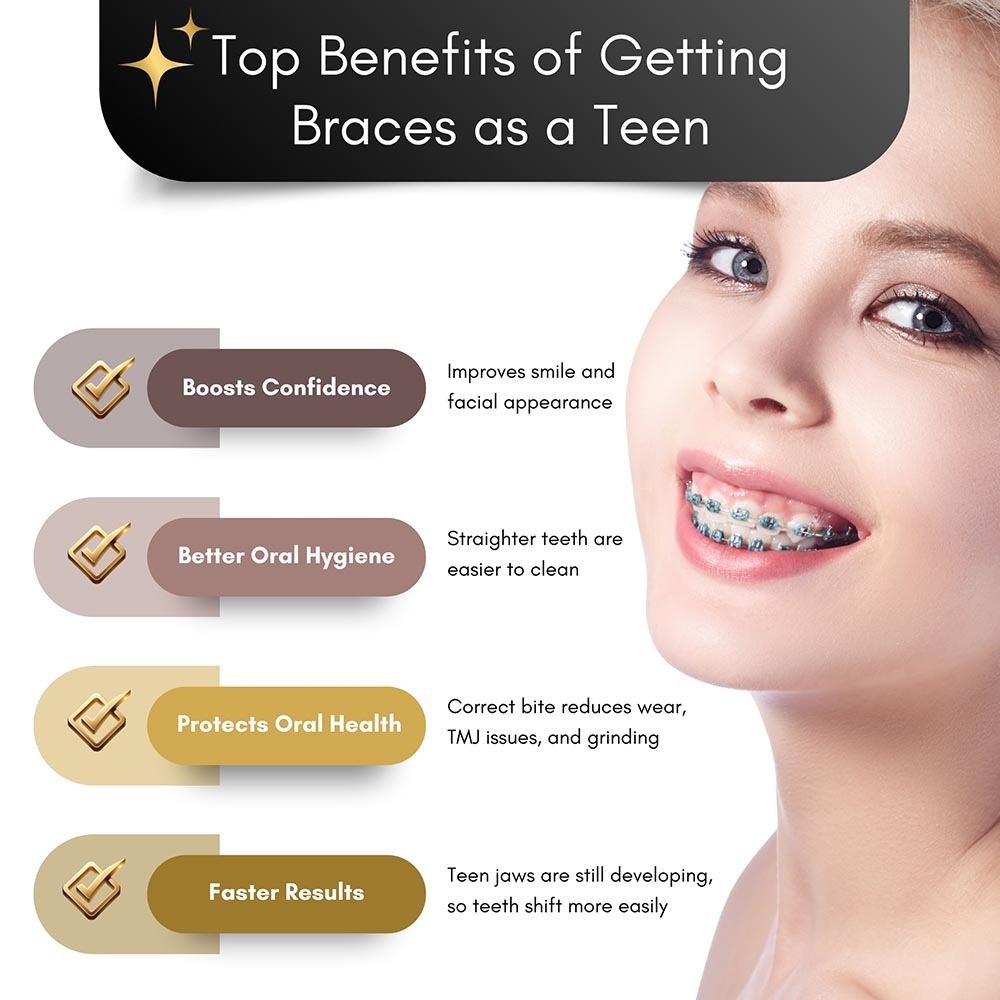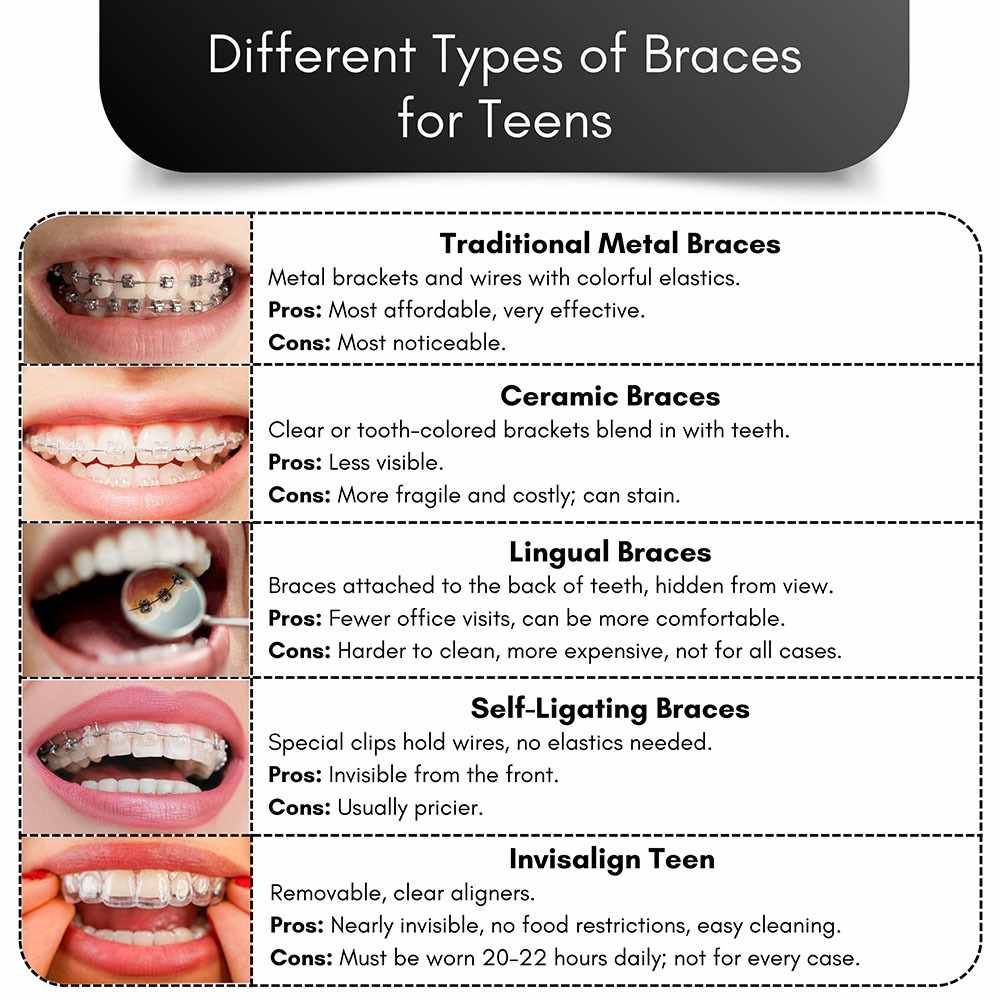When Do Teenagers Need to Start Wearing Braces?
Usually, teenagers receive orthodontic treatment as they transition from baby to permanent teeth, from age 11 to 15, but this can vary. Receiving orthodontic treatment during this period can help maximize the results, using a time when teeth and jaws are still developing and growing.
Will My Teen Need Braces?
Some teenagers have naturally straight smiles, but over half of teenagers in the US will wear braces before they reach adulthood or would benefit from treatment.
If your teen sees a pediatric dentist regularly, they can monitor how their teeth and jaws develop and recommend an orthodontic evaluation if appropriate. If you are concerned and think your teen needs braces, schedule an appointment with our orthodontist directly.
Braces can correct many awkward or potentially harmful oral health problems, including:
- Overbites.
- Underbites.
- Crossbites.
- Open bites.
- Gaps between teeth.
- Crooked teeth.
- Overcrowded teeth.
What Are the Benefits of Wearing Braces as a Teen?
There are numerous benefits to wearing braces, especially during your teenage years. Some of these benefits are outlined below.

Appearance
For a start, it’s highly likely that many of your teen’s friends or peers are in the same position, so having visible braces is less of an issue. Wearing braces can significantly improve the appearance of your teen’s teeth. By realigning your teenager’s teeth, our Invisalign dentists in Brooklyn can create a fuller, more attractive smile and a nicer facial profile.
Improved Oral Hygiene
Trying to clean teeth that are overlapping or tightly packed in is tricky. Even if your child is vigilant about oral care, they likely struggle to remove all plaque and food debris between their teeth.
Failing to clean teeth properly increases their risk of tooth decay and gum disease in the future. By straightening their teeth, you help give them the best possible chance of enjoying a healthy smile for life.
Improved Oral Health
Realigning crooked teeth so they bite together properly also helps to protect them. When your teen’s teeth bite together properly in the correct occlusion, they are less likely to wear down too quickly. The correct bite also helps protect their jaw joints so they are less at risk of developing problems like teeth grinding and clenching (bruxism) and temporomandibular joint disorders (TMJ).
Children’s Teeth Are Easier to Shift
Your child’s teeth and jawbone are still growing and developing, so these bones are softer. It’s easier for our orthodontist to move teeth through a softer jawbone so treatment can be faster.
Completing an Earlier Orthodontic Treatment Plan
Often, braces for teens are the second phase of orthodontic treatment. The first phase, or early orthodontic treatment, would have taken place from age five or six onward. Sometimes early orthodontic treatment can correct problems caused by mouth breathing, thumb sucking, or tongue thrusting.
For example, early orthodontic treatment, like wearing a palate expander, can create a wider upper jaw that more easily accommodates adult teeth. When they have braces during their teens, treatment is more likely to focus on cosmetically improving their smile rather than correcting major issues. It’s more like the finishing touch to their treatment plan.
Different Types of Braces for Teens
There are several types of braces for teens. These include:
- Traditional metal braces.
- Ceramic braces.
- Lingual braces.
- Self-ligating braces.
- Invisalign Teen.

- Traditional Metal Braces
You probably already know these braces and may have worn them yourself during your teens. However, modern metal braces are more comfortable and lighter.
They have metal brackets cemented onto teeth connected to thin wires called archwires. Small elastic bands that come in various colors hold the wires in place. Once all are connected, they gently push teeth into the proper positions.
Metal braces are still popular and provide excellent and predictable results, especially for more complex tooth movements. They are also the most economical but are highly visible. They are a great choice for teens with more self-confidence. Many teens use brightly colored elastics for self-expression.
If your teen is slightly more self-conscious or nervous about having braces, you may want to investigate another less visible solution.
- Ceramic Braces
These braces work the same way as traditional metal braces, but instead, the brackets are made from clear or tooth-colored ceramic material, making them less noticeable. The archwires can also be tooth-colored to blend in more discreetly.
These braces are more fragile than metal braces and are more expensive. The ceramic brackets can stain if not cared for properly, but they are a good choice for teens who dread wearing metal braces.
- Lingual Braces
Lingual braces fit on the inner surfaces of teeth, so they are nearest to the tongue and less visible. The brace brackets are thinner than ordinary metal braces to feel more comfortable.
These braces are only suitable in specific circumstances and are not right for everyone. Because they are fitted on the inner surfaces of teeth, they tend to be trickier to keep clean. Therefore, committing to a good oral hygiene routine is vital.
Lingual braces are more expensive since the brackets must be custom-made.
- Self-Ligating Braces
The self-ligating braces work similarly to traditional metal and clear braces, but the brackets are shaped slightly differently. They are designed to be self-ligating, meaning they automatically tighten and hold the arch wires in place. Therefore, there is no need for elastics.
These braces also tend to be more expensive due to the design of the brackets and the technology involved. They can provide excellent results, sometimes quite quickly, when only more cosmetic tooth movements are needed.
- Invisalign Teen
Specially developed for teenagers, this is Invisalign’s removable aligner system. Instead of fixed braces, teens use a series of clear, virtually invisible plastic aligners.
Because they are removable, your teen will find it easy to clean their teeth, following the normal oral care routine. They are removed for meals, so there is no need for any dietary changes.
The aligners have special wear indicators so parents can check they are worn for the correct length of time. Invisalign Teen can also accommodate teeth that have yet to erupt.
Invisalign Teen can be a great choice for self-conscious teenagers committed to following the treatment plan. If your teen uses the system they must commit to wearing the aligners all of the time and for 20 to 22 hours daily. Otherwise, they may be better off wearing fixed braces that work continuously. After completing Invisalign Teen or any braces treatment, wearing teeth retainers is crucial to maintain the alignment and prevent regression.
What Our Patients Are Saying
Will Insurance Cover the Cost of Braces for Teens?
Dental insurance is most likely to cover the cost of braces for your teen, as many plans provide this coverage. However, it is worth checking the small print or asking us for help and advice. Some plans have an annual or a lifetime maximum for orthodontic treatment.
Other plans may only cover the cost of orthodontics if treatment provides oral health benefits, such as correcting problems with a misaligned jaw or teeth. The treatment plan may not cover the cost of braces that only provide more cosmetically oriented benefits.
How to Choose the Right Braces for Your Teen
If you think your teenager needs braces, then it’s best to schedule an appointment with our orthodontist. They can examine your child’s mouth and how their teeth bite together and discuss which options suit them best. There will likely be one or two more suitable systems than others, and our orthodontist can explain why.
Although many teens will love the idea of removable aligners, it’s also worth considering fixed braces. Traditional metal braces can be a more affordable solution, providing excellent treatment outcomes.
Our expert orthodontist Dr. Jacqueline Simons specializes in orthodontic treatments for teens. She will create the most effective treatment plan to help your teen achieve desired smile. Dr. Simons can also help with broken or damaged braces, since she’s an expert emergency teen orthodontist. Contact Brooklyn Invisalign Center at (718) 375-3757.

